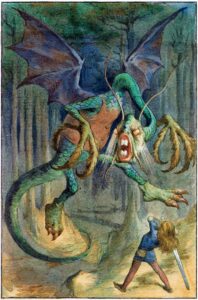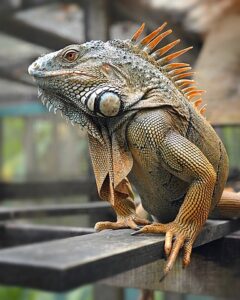
Dragons are not real. That seems true. But…? Dragon myths are found in many civilizations, so must there be some basis in fact? What about a pterodactyl, iguana, or Komodo Dragon?
 First off, what is a dragon anyways. Dragons are described “in the mythologies, legends, and folktales of various cultures, as a large lizard- or serpent-like creature, conceived in some traditions as evil and in others as beneficent. In medieval Europe, dragons were usually depicted with wings and a barbed tail and as breathing fire. In East Asian mythologies the dragon… is conceived as a beneficent creature. Both Chinese and Japanese dragons, though regarded as powers of the air, are usually wingless.“ (https://www.britannica.com/topic/dragon-mythological-creature)
First off, what is a dragon anyways. Dragons are described “in the mythologies, legends, and folktales of various cultures, as a large lizard- or serpent-like creature, conceived in some traditions as evil and in others as beneficent. In medieval Europe, dragons were usually depicted with wings and a barbed tail and as breathing fire. In East Asian mythologies the dragon… is conceived as a beneficent creature. Both Chinese and Japanese dragons, though regarded as powers of the air, are usually wingless.“ (https://www.britannica.com/topic/dragon-mythological-creature)
Now, how about some real animals that might be the origins of dragons: iguana, Komodo Dragon or pterodactyl?
“Iguanas are large lizards that can range from 1.2 to 2.0 m (4 to 6.5 ft) in length, including their tails. Iguanas have an exclusively herbivorous diet, foraging exclusively on vegetation and foliage. Found in tropical areas of Mexico, Central America, South America, and the Caribbean.” They do not fly or breathe fire. (https://en.m.wikipedia.org/wiki/Iguana)
 “The Komodo Dragon (Varanus komodoensis) is the largest extant lizard species. The dragon is a monitor lizard of the family Varanidae. It occurs on Komodo Island and a few neighboring islands of the Lesser Sunda Islands of Indonesia. The lizard grows to 3 meters (10 feet) in total length and attains a weight of about 135 kg (about 300 pounds).” (https://www.britannica.com/animal/Komodo-dragon)
“The Komodo Dragon (Varanus komodoensis) is the largest extant lizard species. The dragon is a monitor lizard of the family Varanidae. It occurs on Komodo Island and a few neighboring islands of the Lesser Sunda Islands of Indonesia. The lizard grows to 3 meters (10 feet) in total length and attains a weight of about 135 kg (about 300 pounds).” (https://www.britannica.com/animal/Komodo-dragon)
“Pterodactyl is the common term for the winged reptiles properly called pterosaurs. Pterosaurs lived among the dinosaurs and became extinct around the same time, but they were not dinosaurs. Rather, pterosaurs were flying reptiles.” There were many species which ranged in wing span from ten inches to perhaps 36 feet. “The largest species that would have soared during the Jurassic period – 201.3 million to 145 million years ago – was the Dearc sgiathanach” which had a wing span of around eight feet. (Castro, 2022, Pulsar)
OK, there are critters that have some of the characteristics of dragons, but here is the deciding factor. Dragons always are either hostile or friendly towards humans in an overt, sentient way. The animals above are generally neither. Well now, iguanas do make good pets and they are friendly, just not in the ways dragons are presented in myths.
So, let’s just admit that dragons are not real. Why even raise this point? My point is that dragons capture the imagination. I believe that children learn best when they are interested and their curiosity is aroused. Stories about dragons make children curious. One can build on such curiosity to foster scientific thinking. I found an example from The Kennedy Center. Follow the link below to Elements of Myth which is referenced below to see what I mean. Two more resources, referenced below, explore how to bio-engineer a dragon. Think of the possibilities for students to develop a plan for such a project. Jurassic Park here we come.
Oh, and Happy Gregorian New Year. On the Chinese calendar, February 10 begins a new year and 2024 is the Year of the Dragon.
References
- Could dragons be real? Not in the way we think, Purbita Saha, Popular Science, August 2022.
- Pterodactyl: Facts about pteranodon and other pterosaurs, Joseph Castro, Live Science, October 2022.
- What Do You Mean, That Isn’t a Dinosaur?, Pulsar podcast, Museum of Science in Boston.
- Elements of Myth – How do scientific and mythological stories explain natural phenomena on earth?, The Kennedy Center.
- Making dragons: a speculative scientific adventure, Helen Pilcher, Nature, August 2019.
- How to build your dragon — with science, Bethany Brookshire, Science News Explores, March 2018.
Image Sources
- The Jabberwock by John Tenniel, 1871.
- Male green iguana at the Green Iguana Conservation Project in San Ignacio, Belize by Patricia Guillory, 2019. Licensed under the Creative Commons Attribution-Share Alike 4.0 International license.
 |
| Visits: 9 |
